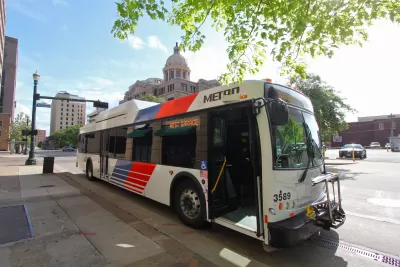Following an "overnight" system redesign, Houston Metro ridership and frequency is up across the board. Its high frequency bus service now rivals that of peer cities on weekends.

Claudia Preciado reports on good news from Houston: an August 2015 bus grid "reimagining" seems to be succeeding. "Typically, service changes are done through a comprehensive operational analysis, followed by an intensive implementation plan of incremental changes over a lengthy amount of time. Metro implemented the entire system redesign in August 2015…overnight. Nearly every bus route was altered with the goal of creating a high-frequency, seven days a week system that increased access to people and jobs."
Houston labors under a reputation for sprawl and sub-par transit. "[Houston's] previous system had 11 lines of high frequency transit lines, defined as service with 15 minute headways or better. Only 25% of the ridership base had access to frequent service under this network."
But that seems to be changing. "On August 16, 2015, the new service redesign enabled riders to travel even further by increasing frequencies, implementing route modifications, and ensuring the transit system served demand. The change meant that 72% of the ridership base now had access to 22 lines with frequent service, seven days a week."
FULL STORY: Houston - the next great (transit) city?

Americans May Be Stuck — But Why?
Americans are moving a lot less than they once did, and that is a problem. While Yoni Applebaum, in his highly-publicized article Stuck, gets the reasons badly wrong, it's still important to ask: why are we moving so much less than before?

Using Old Oil and Gas Wells for Green Energy Storage
Penn State researchers have found that repurposing abandoned oil and gas wells for geothermal-assisted compressed-air energy storage can boost efficiency, reduce environmental risks, and support clean energy and job transitions.

Placekeeping: Setting a New Precedent for City Planners
How a preservation-based approach to redevelopment and urban design can prevent displacement and honor legacy communities.

San Francisco’s Muni Ridership Grew in 2024
The system saw its highest ridership since before the Covid-19 pandemic, but faces a severe budget shortage in the coming year.

Colorado Lawmakers Move to Protect BRT Funding
In the face of potential federal funding cuts, CDOT leaders reasserted their commitment to planned bus rapid transit projects.

Safe Streets Funding in Jeopardy
The Trump administration is specifically targeting bike infrastructure and other road safety projects in its funding cuts.
Urban Design for Planners 1: Software Tools
This six-course series explores essential urban design concepts using open source software and equips planners with the tools they need to participate fully in the urban design process.
Planning for Universal Design
Learn the tools for implementing Universal Design in planning regulations.
Heyer Gruel & Associates PA
City of Moreno Valley
Institute for Housing and Urban Development Studies (IHS)
City of Grandview
Harvard GSD Executive Education
Salt Lake City
NYU Wagner Graduate School of Public Service
City of Cambridge, Maryland


























